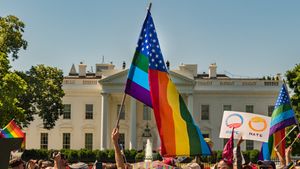Treatment GuideJust DiagnosedSex & DatingAfrican AmericanStigmaAsk the HIV DocPrEP En EspañolNewsVoicesPrint IssueVideoOut 100
CONTACTCAREER OPPORTUNITIESADVERTISE WITH USPRIVACY POLICYPRIVACY PREFERENCESTERMS OF USELEGAL NOTICE
© 2025 Pride Publishing Inc.
All Rights reserved
All Rights reserved
Scroll To Top
By continuing to use our site, you agree to our Privacy Policy and Terms of Use.
At the White House on Tuesday, President Obama plans to announce the first National AIDS Strategy -- the product of 15 months of conversations with thousands of people across the country.
The strategy does not propose a major increase in federal AIDS funding. However, the Administration will be redirecting money to fight the disease in areas with the greatest need and among high-risk groups, including African-Americans and gay and bisexual men, according a final draft of the report obtained by The New York Times. The United States spends more than $19 billion on domestic AIDS programs each year.
Strategy objectives include reducing annual HIV incidence by 25% within five years. The Aadministration wants to cut the rate of transmission, currently five of every 100 people with HIV transmit the virus annually, by 30%. If the rate goes unchanged, within a decade, the number of new infections would increase to more than 75,000 per year and the number of people living with HIV would grow to more than 1.5 million, according to the report. Currently, about 56,000 people become infected each year, and more than 1.1 million Americans are estimated to have HIV.
An estimated 21% of HIV-positive people do not know they are infected; the plan seeks to cut that figure to 10% by 2015. The United States also should "increase the proportion of newly diagnosed patients linked to clinical care within three months of their HIV diagnosis to 85%" from the current rate of about 65%, the report says.
Even with the new health care law, federal AIDS programs such as Ryan White will still be needed to address gaps in AIDS care, the report suggests. States with the lowest number of HIV cases often receive the most money per case. Instead, the report says, federal assistance should be directed to states with the highest burden of disease.
From our Sponsors
Most Popular
Grindr is reminding us why jockstraps are so sexy and iconic
May 02 2025 5:36 PM
BREAKING: Supreme Court rules to save free access to preventive care, including PrEP
June 27 2025 10:32 AM
Discover the power of Wellness in your life
March 26 2025 12:41 PM
Two right-wing Supreme Court justices signal they may uphold access to PrEP and more
April 21 2025 4:10 PM
Plus: Featured Video
Latest Stories
“So much life to live”: Eric Nieves on thriving with HIV
September 03 2025 11:37 AM
The Talk: Beyond the exam room
August 13 2025 3:15 PM
Thanks to U=U, HIV-positive people can live long, happy, healthy lives
July 25 2025 2:37 PM
“I felt like a butterfly”: Niko Flowers on reclaiming life with HIV
July 23 2025 12:22 PM
500,000 Children at Risk: PEPFAR Funding Crisis
April 08 2025 3:51 PM
The Talk Season 5 premieres this spring with HIV guidance for the newly diagnosed
March 26 2025 1:00 PM
The Talk: Owning your voice
August 25 2025 8:16 PM
The lab coat just got queer
August 21 2025 10:00 AM
The Talk: Navigating your treatment
August 01 2025 6:02 PM
How the Black AIDS Institute continues to fill in the gaps
July 25 2025 1:06 PM
1985: the year the AIDS crisis finally broke through the silence
June 26 2025 11:24 AM
Trump admin guts $258 million in funding for HIV vaccine research
June 03 2025 3:47 PM
Messenger RNA could be the key to an HIV vaccine — but government cuts pose a threat
August 20 2025 8:02 AM
The Talk: Starting the conversation
July 25 2025 4:47 PM
Dancer. Healer. Survivor. DéShaun Armbrister is all of the above
July 02 2025 8:23 PM
VIDEO: A man living with HIV discusses his journey to fatherhood
June 10 2025 4:58 PM
HRC holds 'die-in' to protest Trump health care cuts
April 28 2025 2:11 PM
Broadway's best raise over $1 million for LGBTQ+ and HIV causes
April 03 2025 7:15 PM







































































